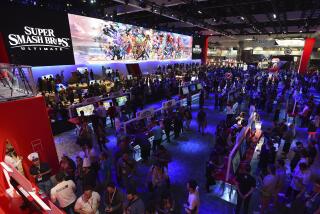SPORTS EXTRA / RYDER CUP : INSIDE THE INDUSTRY : Exhibitors Leaving Las Vegas to Trade on Orlando’s Success
- Share via
Maxfli Golf is excited about its new Maxfli Belt Bag. A press release trumpets the bag, which reduces the weight carried by the back and shoulders and shifts it to the hips, as “innovative” and “revolutionary.”
A natural, in other words, to be shown off at the PGA International Golf Show, which runs Tuesday through Thursday in Las Vegas.
But the bag won’t be there, and neither will Maxfli.
The Greenville (S.C.) company is one of several industry heavyweights--besides Ping, Titleist, Taylor Made and the Greg Norman Collection, to name a few--that have pulled out of the trade show, which is expected to draw about 20,000 industry types to the Las Vegas Convention Center.
Clearly, many of the industry’s biggest names don’t believe the advertisements for the show, which warn, “This September, not going to Vegas will be the biggest gamble of all.”
“Obviously, a lot of people are willing to take that risk,” says Edward Hughes, vice president of marketing for Maxfli.
Citing the high cost of attending trade shows, several of the industry’s big guns are starting to question whether the golf-equipment industry really needs two major trade shows each year.
A point on which there seems to be no question is that the PGA Merchandise Show, held in Orlando, Fla., early in the year, is the king of golf shows.
Last January, the Orlando show attracted a record 1,406 exhibitors and more than 50,000 people.
Its tremendous success, however, seems to have put the squeeze on the Las Vegas show, which draws about 800 exhibitors.
Says Hughes: “From an industry profitability perspective, the industry really can’t afford to have two trade shows, particularly when one of the shows is so much larger and you can achieve a lot of your goals by focusing on one.”
Kevin May, direct-marketing manager for Taylor Made, says the Las Vegas show has outlived its usefulness.
“The traffic [in Las Vegas] has been down the last couple years,” he says. “So we felt that we could better use our resources by focusing on the larger show in Orlando.”
Representatives of Spalding Sports and Ping expressed similar views, Ping Chairman John Solheim telling the Associated Press that Ping may never return to the Las Vegas show.
All the better for the companies that are planning to attend, says Bruce Parker, executive vice president of sales at Callaway, which has set up shop at the International show every year since the company’s launch in 1984.
“We’re delighted our competitors pulled out,” says Parker. “In our opinion, the best place to sell golf clubs is where the buyers are, and our conversations with our customers tell us that they’re going to be in Las Vegas.”
The Las Vegas show has lived in the shadow of the Orlando show since it was started by the Southern California PGA Section in 1980 as primarily a regional event. The PGA of America bought the rights to the show in 1992, moved it to Las Vegas in 1995 and then sold the rights to both the Orlando and Las Vegas shows last year to Reed Exhibition Co. for $122 million.
Unlike some others in the industry, Parker doesn’t foresee the demise of the Las Vegas show.
“Every company that pulled out thought there was a need for two shows for the last 20 years,” he says.
“This is the first year they’ve decided we don’t need two. I find that a little odd. And I think it’s because profits are harder to come by these days. It’s become harder to make money the last few years.
“But it’s a good investment to spend time with your customers, and I think you’ll see a lot of these companies coming back.”
Gail Billingsley, marketing director for both shows, says the attention given the pullouts has been overblown, though she agrees that for some companies, two trade shows a year may be one too many.
But that doesn’t mean the Las Vegas show can’t remain viable. According to research provided by Reed, about 60% of the attendees at the Las Vegas show do not attend the Orlando show.
So what is its future?
“Very solid,” says Billingsley. “It’s the second-largest golf industry trade show in the world. It’s hard to walk away from that.”
More to Read
Go beyond the scoreboard
Get the latest on L.A.'s teams in the daily Sports Report newsletter.
You may occasionally receive promotional content from the Los Angeles Times.










